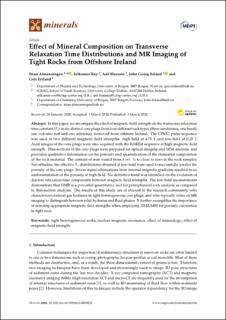| dc.contributor.author | Almenningen, Stian | |
| dc.contributor.author | Srikumar, Roy | |
| dc.contributor.author | Hussain, Arif | |
| dc.contributor.author | Seland, John Georg | |
| dc.contributor.author | Ersland, Geir | |
| dc.date.accessioned | 2021-05-27T10:44:36Z | |
| dc.date.available | 2021-05-27T10:44:36Z | |
| dc.date.created | 2021-01-20T18:44:08Z | |
| dc.date.issued | 2020 | |
| dc.Published | Minerals. 2020, 10 (3), 232-?. | |
| dc.identifier.issn | 2075-163X | |
| dc.identifier.uri | https://hdl.handle.net/11250/2756600 | |
| dc.description.abstract | In this paper, we investigate the effect of magnetic field strength on the transverse relaxation time constant (T2) in six distinct core plugs from four different rock types (three sandstones, one basalt, one volcanic tuff and one siltstone), retrieved from offshore Ireland. The CPMG pulse-sequence was used at two different magnetic field strengths: high-field at 4.70 T and low-field at 0.28 T. Axial images of the core plugs were also acquired with the RAREst sequence at high magnetic field strength. Thin-sections of the core plugs were prepared for optical imaging and SEM analysis, and provided qualitative information on the porosity and quantification of the elemental composition of the rock material. The content of iron varied from 4 wt. % to close to zero in the rock samples. Nevertheless, the effective T2 distributions obtained at low-field were used to successfully predict the porosity of the core plugs. Severe signal attenuations from internal magnetic gradients resulted in an underestimation of the porosity at high-field. No definitive trend was identified on the evolution of discrete relaxation time components between magnetic field strengths. The low-field measurements demonstrate that NMR is a powerful quantitative tool for petrophysical rock analysis as compared to thin-section analysis. The results of this study are of interest to the research community who characterizes natural gas hydrates in tight heterogeneous core plugs, and who typically relies on MR imaging to distinguish between solid hydrates and fluid phases. It further exemplifies the importance of selecting appropriate magnetic field strengths when employing NMR/MRI for porosity calculation in tight rock. | en_US |
| dc.language.iso | eng | en_US |
| dc.publisher | MDPI | en_US |
| dc.rights | Navngivelse 4.0 Internasjonal | * |
| dc.rights.uri | http://creativecommons.org/licenses/by/4.0/deed.no | * |
| dc.title | Effect of Mineral Composition on Transverse Relaxation Time Distributions and MR Imaging of Tight Rocks from Offshore Ireland | en_US |
| dc.type | Journal article | en_US |
| dc.type | Peer reviewed | en_US |
| dc.description.version | publishedVersion | en_US |
| dc.rights.holder | Copyright 2020 by the authors. | en_US |
| dc.source.articlenumber | 232 | en_US |
| cristin.ispublished | true | |
| cristin.fulltext | original | |
| cristin.qualitycode | 1 | |
| dc.identifier.doi | https://doi.org/10.3390/min10030232 | |
| dc.identifier.cristin | 1875949 | |
| dc.source.journal | Minerals | en_US |
| dc.source.40 | 10 | |
| dc.source.14 | 3 | |
| dc.identifier.citation | Minerals. 2020, 10 (3), 232. | en_US |
| dc.source.volume | 10 | en_US |
| dc.source.issue | 3 | en_US |

